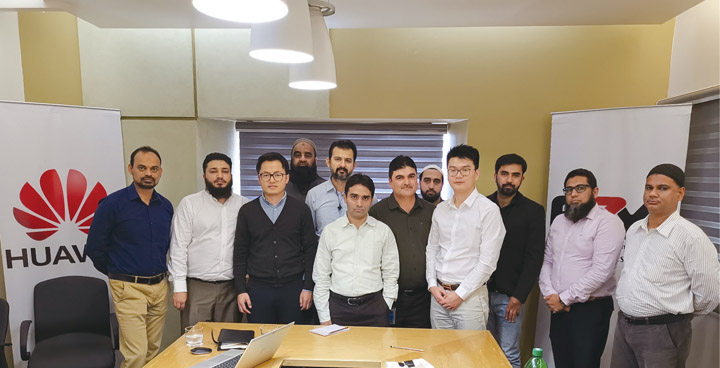EZY Pakistan: Breaking Barriers and Building Supply Expressways
Продукти, рішення, послуги для організацій

Headquartered in Singapore, EZY operates in 15 Asian countries, including the Philippines, Vietnam, Indonesia, India, and Pakistan. In 2015, EZY became a Huawei distributor in Pakistan. It focused on selling mainstream Internet Protocol (IP) and Information Technology (IT) products, covering industries such as finance, education, and electric power. In just a few years, the Compound Annual Growth Rate (CAGR) reached 50 percent, and EZY became a top distributor in Pakistan’s ICT industry.
During the rapid development of Huawei’s enterprise business in Pakistan, Huawei encountered many difficulties in supply collaboration with EZY. When Huawei’s supply chain team visited EZY’s partners, EZY’s business director pointed out that Huawei’s supply period was abnormally long, and the logistics efficiency was low. The challenge was to find a way to achieve efficient production and sales collaboration, break down the two major ‘barriers’ — the long supply period and the inefficiency of the collaboration — and build a more efficient supply lane.
In 2018, Pakistan’s foreign exchange policy tightened (the foreign exchange reserve was set at less than US$10 billion), the rupee seriously depreciated, the trade profit levels of Small- and Medium-sized Enterprises (SMEs) decreased, and the other foreign exchange performance indicators declined. The nation’s End-to-End (E2E) supply period was 24 days, ranking last in the Middle East. EZY failed to obtain rebates on Management By Objective (MBO) supply incentives. Meanwhile, the demand for improving efficiency and reducing costs was increasing for channel partners at all levels.
Huawei Supply Chain and EZY organized a channel supply meeting with Tier-2 agents in the Karachi region. By listening to all of the parties’ requirements and suggestions and reviewing internal cases after the meeting, Huawei and EZY identified six major obstacles to building a fast supply track.
• PSI management wasn’t well coordinated, and long lead times for materials weren’t accurately forecast.
• Quasi-terminal products were subject to the production mode (Original Equipment Manufacturer), resulting in a long production period.
• Because of the deterioration of the international trade environment, the Pakistan’s customs office now requires an approval of Import Contract (IC).
• The number of freight forwarders was high — 58 — and their qualities and capacities varied significantly.
• The estimated goods volume was inaccurate, or the packing list couldn’t be provided in time.
• When applying for a customs clearance Type Approval Certificate (TAC) — an import license used for customs clearance of terminal-type spectrum equipment — each party was responsible for its own operation. The process was long and had to be repeated by each party.
Huawei Supply Chain outlined the supply business process, pain points, and requirements to EZY. After learning about the partner’s business plans and annual requirements for important products, Huawei Supply Chain took on various challenges and analyzed the feasibility of multiple measures based on real-world scenarios. The supply chain set three targets: shorten the E2E supply cycle, improve logistics quality and reduce the number of freight forwarders, and switch the supply center to Dubai.
Our strategy of steady growth requires us not to think opportunistically to seek quick results and instant benefits. Instead, Huawei Supply Chain, together with customers and partners, must work together to build a solid foundation and make continuous improvement based on optimization solutions.
• Optimize the goods preparation process and shorten the goods preparation time: EZY reported that the Optical Network Terminal (ONT) product supply period was long (45 days). Huawei and the distributor proactively visited Cybernet, an ISP customer in Karachi, to gain insight into its specific requirements for the lead time supply. The customer also shared the internal PSI system with Huawei. By optimizing the internal risk control and applying for the advance stock channel of the supply center, EZY solved the problem regarding quasi-terminal products, which were criticized by the customer because of the long lead time. The production and shipment can now be completed within a week of the Purchase Order (PO) being issued.
• Optimize the estimation system and align it with the offline shipment: We urged IT personnel to optimize the goods volume estimation system based on the instances in which deviations from estimates occurred, improved the accuracy of real-time shipment data, reduced the inaccurate logistics costs incurred because of inaccurate volume estimates, and helped channel partners move the logistics booking time from after production to before production, reducing the waiting time of the serial process and achieving efficient logistics delivery between both parties.
• Optimize the logistics cooperation mode and improve the booking efficiency: EZY originally delivered free on board (FOB) contracts to more than 10 Tier-2 resellers with limited logistics capabilities at the departure port for transportation. After quantitative comparison and analysis of statistics, they identified efficiency weaknesses in specific logistics links, worked with EZY and Tier-2 resellers to discuss optimization measures, and designed and applied logistics MBO incentives. EZY will gradually reduce the proportion of Tier-2 resellers’ transportation. When more mainstream freight forwarders are used for logistics booking, the booking period will be shortened from seven to ten days to two to three days.

• Optimize the customs clearance waiting period and reduce the application cost: Pakistan has strict foreign exchange controls, so Huawei Supply Chain’s ability to provide expert enablement for partners while providing great services is critical to this partnership. It proactively streamlines its internal process, applies for IC in advance, to adapt to new scenarios, and guides customers to apply for IC, reducing the shipment waiting time by three days.
For example, Huawei Supply Chain proactively applied for TACs from Pakistan Telecom Authority (PTA) in advance and authorized agents at all levels. This solved the problems that were caused by being unable to share TACs among channels, and reduced the application time by 15 days on average.
Through a series of optimization measures for in-depth collaboration between the two parties, the E2E supply period was shortened to 13.1 days in 2019 — 11 days shorter than that of 2018. EZY obtained MBO supply incentives for the first time, ranking first among all distributors in the Middle East. Channel partners at all levels also appreciated Huawei’s proactive application for TAC authorization for agents at all levels. This was exemplified in a third-party customer satisfaction survey in which Huawei Supply Chain scored 81.7 points — 8.7 points more than any of its competitors.

Huawei Supply Chain and seven Tier-2 resellers gathered at EZY headquarters in Karachi for a workshop
Huawei Supply Chain and EZY will conduct wider supply collaboration and streamline the supply model from the Dubai supply center to local supply centers. This will further shorten Huawei’s product supply cycle for end customers (25 days for sea transportation and 10 days for air transportation). Huawei’s supply will be upgraded from fast lanes to expressways, which will support EZY’s business expansion, as well as other channel partners, and achieve benefits for Huawei, channel partners, and customers at all levels.